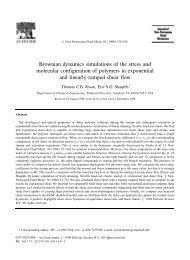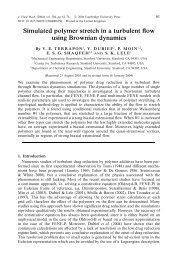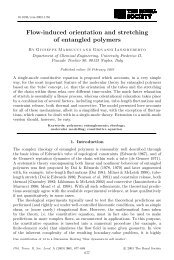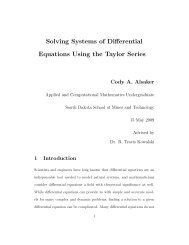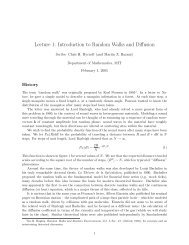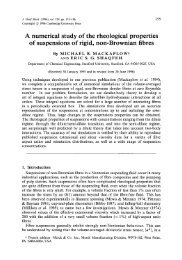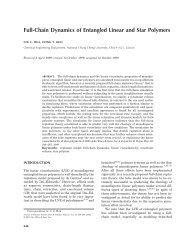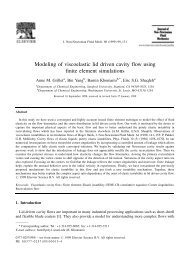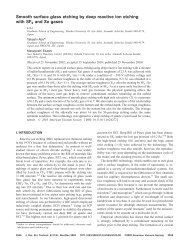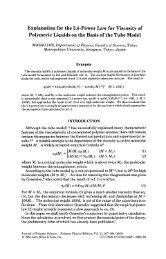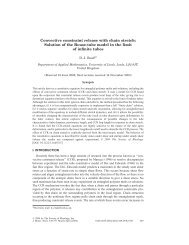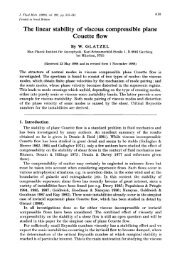Molecular modelling of entangled polymer fluids under flow The ...
Molecular modelling of entangled polymer fluids under flow The ...
Molecular modelling of entangled polymer fluids under flow The ...
Create successful ePaper yourself
Turn your PDF publications into a flip-book with our unique Google optimized e-Paper software.
¡ ¡ ¡ ¡ ¡ ¡ ¡<br />
¡ ¡ ¡ ¡ ¡ ¡ ¡<br />
2.2. GAUSSIAN CHAINS 13<br />
¡ ¡ ¡ ¡ ¡ ¡ ¡<br />
b<br />
Figure 2.1: Sketch <strong>of</strong> an N-step freely jointed random walk<br />
R<br />
In addition, r is the sum <strong>of</strong> many random vectors <strong>of</strong> fixed length so, if N is sufficiently<br />
large, the probability density <strong>of</strong> r can be shown to tend to the following Gaussian<br />
distribution.<br />
Ψ(r) =<br />
2.2.2 Justification <strong>of</strong> the model<br />
( ) 3 3/2 )<br />
2πNb 2 exp<br />
(− 3r2<br />
2Nb 2 . (2.2)<br />
Some limitations <strong>of</strong> using Gaussian statistics to model the static properties <strong>of</strong> a <strong>polymer</strong><br />
chain are immediately apparent. A random walk <strong>of</strong> N steps <strong>of</strong> length b has a maximum<br />
possible end to end vector length <strong>of</strong> Nb corresponding to the case in which all <strong>of</strong> the<br />
bonds point in the same directions. Yet equation 2.2 assigns a non-zero probability to<br />
vector lengths in excess <strong>of</strong> this value. In practice, as long as N is reasonably large the<br />
probability <strong>of</strong> achieving these unphysically large end to end vectors is small enough to<br />
have a negligible effect on the chain properties. Under very large and rapid deformations<br />
a chain can be unravelled sufficiently to approach its maximum extensibility and in this<br />
case a more detailed counting <strong>of</strong> microstates must be used.<br />
Why take each monomer step to be freely jointed? <strong>The</strong>re are examples <strong>of</strong> more<br />
detailed models <strong>of</strong> long chain molecules in which each bond direction is constrained to<br />
be related to the previous bond in the chain. However, so long as these correlation<br />
decay over some distance along the chain and the chain length is long compared with<br />
this distance, the value <strong>of</strong> 〈 r 2〉 still scales with the first power <strong>of</strong> N. <strong>The</strong> effect <strong>of</strong> these<br />
local bond correlations merely renormalises the bond length, b. This renormalised step<br />
length is known as the Kuhn statistical step length. <strong>The</strong> results presented so far still<br />
hold for weakly correlated random walks provided b is Kuhn step length rather than<br />
the raw bond length value.<br />
Another key assumption for the use <strong>of</strong> Gaussian chains is that interactions between<br />
two points which are well separated along the chain are neglected. Although plausible



